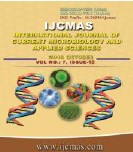


 National Academy of Agricultural Sciences (NAAS)
National Academy of Agricultural Sciences (NAAS)

|
PRINT ISSN : 2319-7692
Online ISSN : 2319-7706 Issues : 12 per year Publisher : Excellent Publishers Email : editorijcmas@gmail.com / submit@ijcmas.com Editor-in-chief: Dr.M.Prakash Index Copernicus ICV 2018: 95.39 NAAS RATING 2020: 5.38 |
Co-inoculation of Arbuscular mycorrhizal fungi (AMF) and certain species of Plant Growth Promoting Rhizobacteria (PGPR) help to bring the poorly soluble nutrients into the soil solution, thus enhancing nutrient uptake. The present investigation was carried out with objectives to study the effect of co-inoculation of AMF and PGPR (viz. Burkholderia cepacia and Azospirillum brasilense) on soil Zn fractions and Zn uptake by maize. A field experiment was conducted in Randomized Block Design with 9 treatments, each replicated thrice. The treatments included an absolute control and 100 % recommended fertilizer dose along with different combinations of AMF with PGPR at varied P doses. Laboratory analysis of experimental soil for Zn fractions and plant-available Zn was done at 2 stages viz., at flowering and after harvesting. Results from the experiment obtained at both the stages show highest values for grain Zn content (52.58 mg kg-1) and its uptake (0.390 kg ha-1) under the treatment where AMF@10kg/ha + Burkholderia cepacia @20g/kg seed + Azospirillum brasilense @20 g/kg seed + 75%P was used. Residual fraction of Zn comprised of more than 80 % of total soil Zn while water soluble-exchangeable Zn accounted for the least (about 1%). The co-inoculation treatments had a significant effect on the water soluble-exchangeable and organically bound Zn, while the oxide bound Zn fractions had higher values in the non-organic treatments i.e. Control (13.4 mg kg-1) and 100% RDF (12.9 mg kg-1). The results for co-inoculation effects can be considered as possible strategies towards improving Zn nutrition to plants.
 |
 |
 |
 |
 |